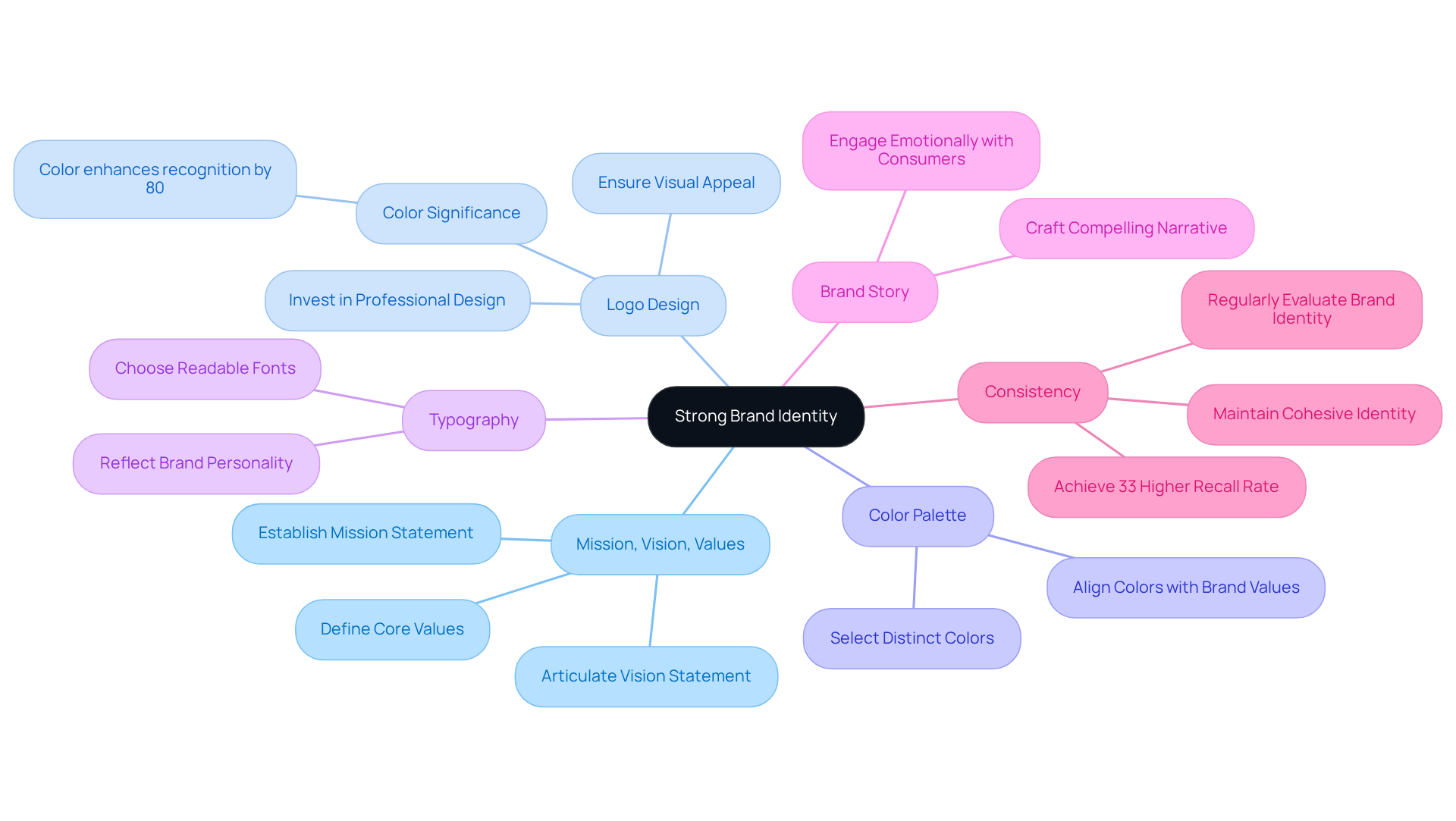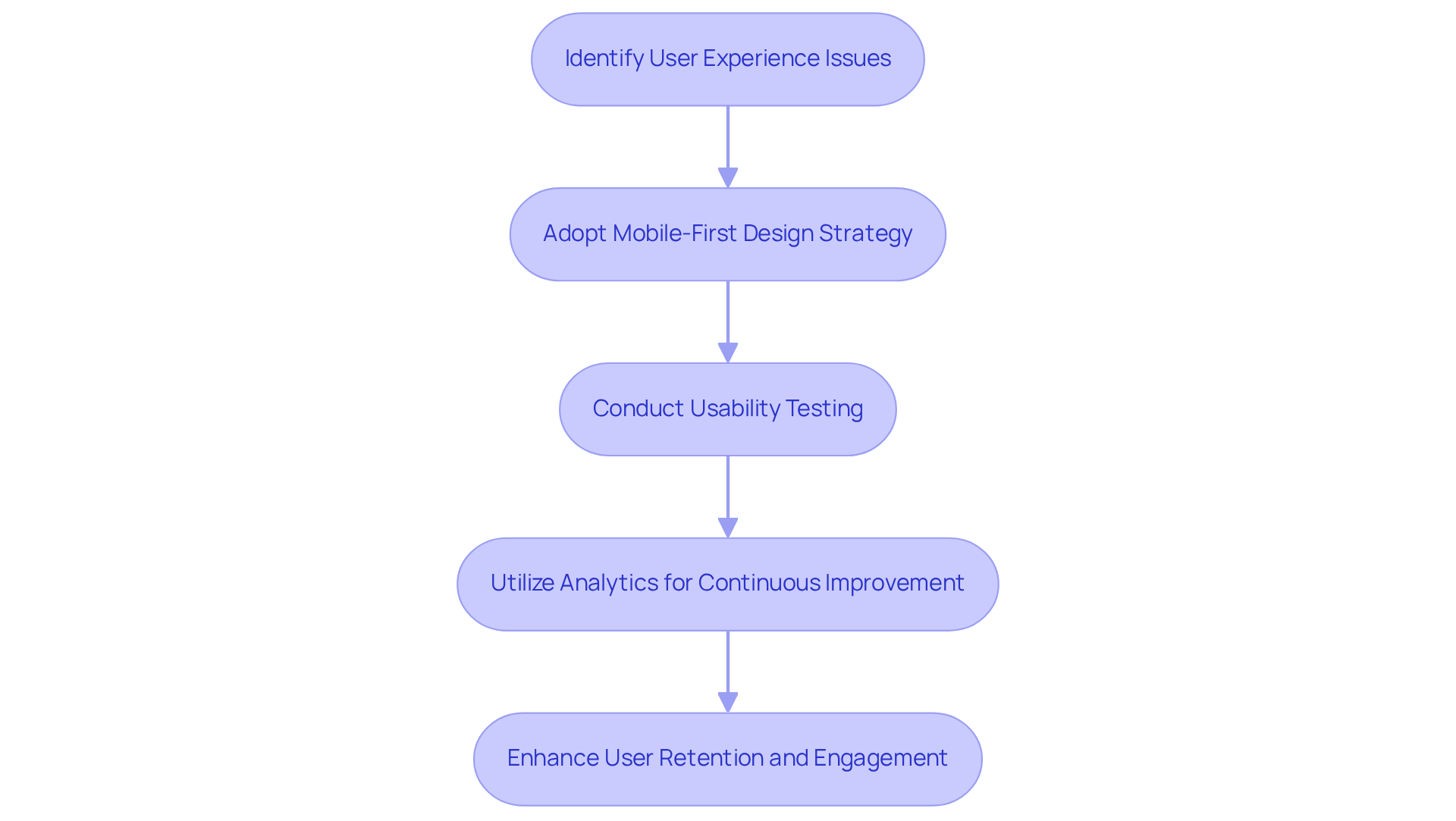Introduction
Creating an impactful online presence can feel overwhelming for tech startups, especially in a bustling place like Washington DC. Many founders struggle with the nuances of web design, and this can mean the difference between engaging potential customers or losing them to competitors. As the digital landscape continues to evolve, it’s natural to wonder: how can startups ensure their websites not only attract but also retain users?
This article explores four best practices that empower tech companies to connect meaningfully with their audience and build a strong brand identity. By navigating the challenges of responsive design and performance marketing, we aim to provide you with the support you need. Remember, you’re not alone in this journey; many have faced similar hurdles and found ways to thrive. Let’s dive into these practices together, fostering a sense of community and understanding as we work towards your startup’s success.
Understand Your Target Audience and Their Needs
Creating a compelling online presence can feel overwhelming for technology companies, especially when it comes to identifying the right audience. Many founders struggle with understanding who their ideal customers are, which can lead to frustration and wasted resources. This challenge is particularly pressing as we look toward 2025, where demographic trends and preferences are rapidly evolving.
Imagine pouring time and money into a website that doesn’t resonate with your audience. It’s a painful reality that many face. But there’s hope! By conducting thorough market research, you can uncover valuable insights that will guide your decisions. Tools like surveys, interviews, and analytics can illuminate the preferences and pain points of your target demographic. Mobile-first surveys are becoming a go-to method, as highlighted by GreenBook, making it easier than ever to gather feedback.
Developing user personas is a crucial step in this process. These personas encapsulate the traits of your ideal customers and inform your design decisions, ensuring your website truly resonates with users. For instance, if you’re targeting young professionals, a sleek, modern design with streamlined access to information might be the way to go. On the other hand, a B2B technology company might focus on detailed content and case studies to build credibility.
It’s essential to refresh these personas regularly, as market dynamics are always changing. Staying in tune with your audience’s evolving needs can make all the difference. Did you know that 70% of all market research spending goes into five key areas, including audience research? This statistic underscores just how vital it is to invest in understanding your audience.
Additionally, recognizing that the average age of new business founders is 42 years old can provide insight into the typical demographic for technology enterprises. This knowledge can help tailor your approach and messaging.
However, it’s important to be cautious. Misapplying market research practices can lead to misguided strategies and wasted resources. By approaching this process with care and intention, you can create a strong foundation for your online presence using washington dc web design and connect meaningfully with your audience.

Establish a Strong Brand Identity
Creating a strong brand identity can feel overwhelming for new enterprises. Many founders struggle with defining their mission, vision, and values, which are essential for setting the right foundation. Imagine pouring your heart into a project, only to find it lost in a sea of competition. This is a common pain point, and it can be disheartening.
To help you navigate this journey, start by:
- Designing a distinctive logo
- Selecting a color palette
- Choosing typography that truly embodies your brand's personality
Consistency is key across all platforms-your website, social media, and marketing materials. Brands that maintain a cohesive identity can achieve a 33% higher recall rate and potentially increase revenue by up to 23%.
Take RNO1's strategic rebranding of Founder's Haven as an inspiring example. They transformed a tech company’s identity to empower modern founders for digital success. By utilizing bold colors and modern fonts, they project an innovative image. Did you know that color can enhance brand recognition by up to 80%? This is a powerful tool in your branding arsenal.
Crafting a compelling brand story is equally important. Emotionally engaging narratives can significantly enhance user connection and loyalty. In fact, 76% of consumers prefer to buy from brands they feel connected to. This highlights how emotional connections can influence purchasing decisions.
Regularly evaluating your brand identity is crucial to ensure it aligns with your evolving business goals and audience expectations. This ongoing process fosters long-term loyalty and trust. Remember, you’re not alone in this journey. RNO1's performance marketing expertise can guide you in leveraging your brand identity for greater market impact. Together, we can build a brand that resonates deeply with your audience.

Implement Responsive and User-Centric Design
For technology companies, ensuring that their websites are accessible on all devices is a pressing challenge. Many founders know the frustration of losing potential customers due to a poor online experience. Imagine a user trying to navigate a website on their phone, only to be met with clunky buttons and confusing layouts. This can lead to disappointment and, ultimately, a decision not to return. In fact, studies show that 88% of users are less likely to revisit a site after a negative experience. This is a reality that many startups face, especially when 61.5% of website redesigns stem from bad user experiences.
To tackle this issue, adopting a responsive design approach is crucial. Starting with a mobile-first design strategy can make a significant difference. By prioritizing the mobile experience, companies can create a foundation that scales beautifully to larger screens. Utilizing flexible grids and layouts that adapt to various screen sizes is key. It’s also important to integrate design principles that focus on the user. Conducting usability testing allows for valuable feedback on navigation, content arrangement, and overall experience. For instance, a startup might find that implementing touch-friendly buttons and simplified navigation for mobile visitors greatly enhances usability.
Moreover, consistently examining behavior patterns through analytics tools can help pinpoint areas for improvement. As Ashley Bhalerao wisely states, "Based on these insights, you can take the necessary steps to optimize your web design, improve the visitor experience, and identify crucial areas that need your attention." By focusing on these elements, technology companies can significantly enhance user retention and engagement.
With mobile optimization being a priority for 62% of leading websites, it’s clear that these practices are essential for staying competitive. Embracing a responsive design not only addresses immediate concerns but also fosters a nurturing environment for users, ultimately leading to a more successful online presence.

Leverage Performance Marketing Strategies
Navigating the world of performance promotion can feel overwhelming for tech startups. Many founders struggle to find effective strategies that truly deliver measurable outcomes. It’s essential to establish clear promotional goals and key performance indicators (KPIs) that align with your business objectives. When you monitor KPIs early in the sales funnel, you can better understand the success or failure of your promotional efforts, which can be a game changer.
Consider the diverse channels available to you. Pay-per-click (PPC) advertising, for instance, represents a significant portion of digital ad spending. Alongside social media promotion and targeted email campaigns, these tools can help you effectively reach your audience. However, it’s not just about using these channels; it’s about refining your approach. A/B testing can be a powerful ally in enhancing your messaging and design. For example, experimenting with different ad creatives can reveal which ones achieve a higher click-through rate. It’s surprising to note that less than 20% of marketers utilize landing page A/B tests, which highlights a missed opportunity for many.
Moreover, leveraging analytics tools to observe user behavior on your website allows for ongoing enhancement of your promotional efforts. This iterative approach ensures that your strategies adapt based on real-time data, ultimately maximizing your return on investment (ROI). As Dan Shaffer, Director of SEO.com, wisely points out, "Tracking metrics is crucial for understanding where consumers might be encountering obstacles in the sales funnel."
By focusing on these best practices, you can enhance your marketing effectiveness and drive sustainable growth. Remember, you’re not alone in this journey. Many founders face similar challenges, and by sharing experiences and insights, we can foster a supportive community that thrives together.

Conclusion
Building a strong online presence can feel overwhelming for tech startups in Washington DC. Many founders grapple with understanding their target audience and establishing a brand that truly resonates. This struggle can lead to frustration, as attracting visitors without converting them into loyal customers feels like an uphill battle.
Imagine pouring your heart into your startup, only to see potential customers slip away. It’s disheartening, isn’t it? But there’s hope. By conducting thorough market research, you can identify and connect with your ideal audience. Establishing a cohesive brand identity - complete with a distinctive logo and engaging storytelling - can significantly enhance recognition and foster loyalty. And let’s not forget about user experience; adopting responsive design principles ensures that your users enjoy a seamless experience across all devices, which is crucial for retaining potential customers.
The journey to creating an impactful web presence is multifaceted, but it doesn’t have to be daunting. By prioritizing audience understanding, brand consistency, user experience, and data-driven marketing, you can position your startup for success. Embracing these practices not only fosters immediate growth but also lays the groundwork for long-term sustainability in our ever-evolving digital landscape.
Remember, the future of your online presence depends on the strategies you implement today. So, let’s take these insights to heart and move forward together. Your startup deserves to thrive, and with the right approach, it can.
Frequently Asked Questions
Why is understanding the target audience important for technology companies?
Understanding the target audience is crucial for technology companies to create a compelling online presence and avoid wasting resources on strategies that do not resonate with their ideal customers.
What challenges do founders face when identifying their ideal customers?
Many founders struggle to identify their ideal customers, leading to frustration and inefficiencies, particularly as demographic trends and preferences evolve.
How can market research help in understanding the target audience?
Conducting thorough market research can uncover valuable insights about audience preferences and pain points through tools like surveys, interviews, and analytics.
What are mobile-first surveys and why are they significant?
Mobile-first surveys are surveys designed to be completed on mobile devices, and they are significant because they facilitate easier feedback gathering from the target demographic.
What are user personas and why are they important?
User personas are detailed representations of ideal customers that inform design decisions, ensuring that a website resonates with its users.
How should user personas be maintained over time?
User personas should be refreshed regularly to stay aligned with changing market dynamics and evolving audience needs.
What percentage of market research spending is allocated to audience research?
Approximately 70% of all market research spending goes into five key areas, including audience research, highlighting its importance.
What demographic insight can help tailor messaging for technology enterprises?
Recognizing that the average age of new business founders is 42 years old can provide insight into the typical demographic for technology enterprises, aiding in tailored messaging.
What risks are associated with misapplying market research practices?
Misapplying market research practices can lead to misguided strategies and wasted resources, emphasizing the need for a careful and intentional approach.




